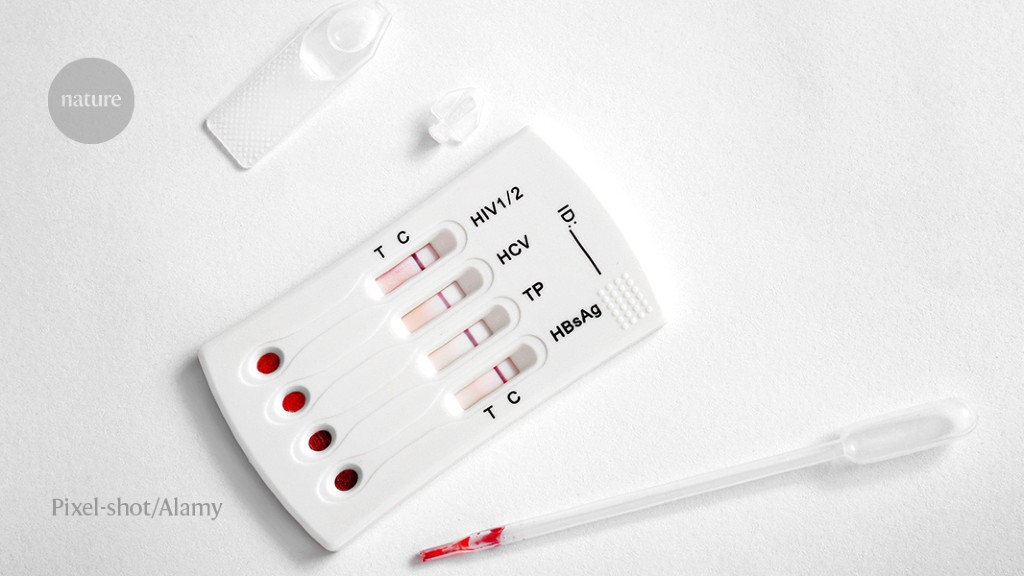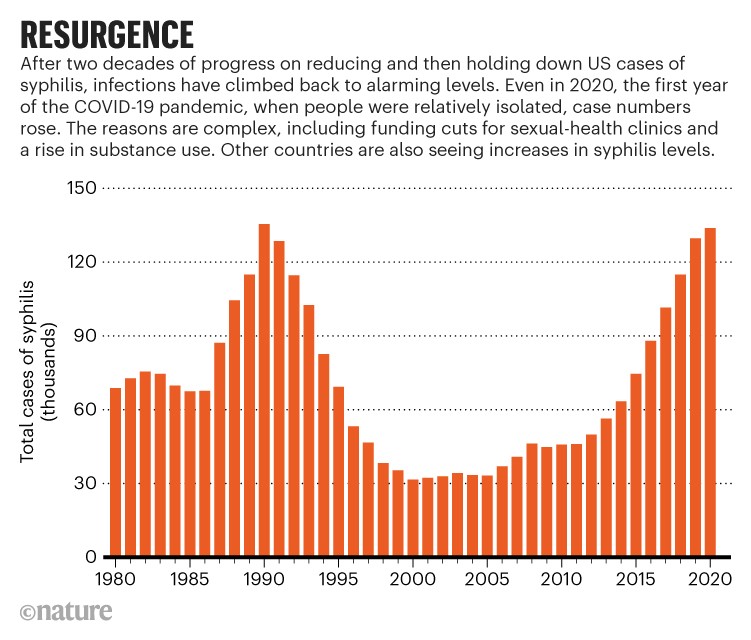Global cases of sexually transmitted infections (STIs) have been on the rise in some countries. Even the COVID-19 pandemic — which locked down life in many ways — hasn’t halted the trend. In April, the US Centers for Disease Control and Prevention reported that the first year of the pandemic saw 133,945 cases of syphilis, a 52% increase since 2016 (see ‘Resurgence’).
And this is probably an underestimate, the CDC says, given that health-care clinics had to limit in-person visits at the start of the pandemic, and STI surveillance programmes found their resources shifted elsewhere. The situation sparked a push for at-home tests for syphilis and other STIs.
Encouraged by the popularity of at-home tests for COVID-19, self-testing has been embraced by many, including policymakers and people in marginalized populations. In January, a California law went into effect that requires private health insurers to cover the cost of at-home STI testing. Supporters say that self-testing has the benefit of allowing individuals to collect samples in the privacy of their homes, free from any stigma that might be associated with attending clinics, and that it allows people from all backgrounds and income levels to test frequently.
But the shift could also have trade-offs — some of them similar to those experienced for COVID-19, cautions Shweta Patel, a gynaecologist at the University of Alabama at Birmingham. With at-home tests, people do not receive the counselling that comes with in-person testing, and public-health departments might lose valuable statistics. Users must report their own results, and perform their own contact tracing to inform others that they might be in need of testing, Patel says, and this doesn’t always happen.
Still, during the pandemic, self-testing for COVID-19 proved to be useful, says Natalie Cramer, deputy executive director of programmes at the National Alliance of State and Territorial AIDS Directors in Washington DC. She adds that it’s past time for a similar approach to be taken for STIs including syphilis and HIV. “I think we’ve all become more comfortable self-testing with COVID,” Cramer says. “It’s opened up both a need and a comfort level that folks have around it.”
Anatomy of a pathogen
For around half a millennium, syphilis has been one of the most widely recognized — and feared — STIs. It spurred the development of the first drug dubbed a magic bullet (salvarsan, an arsenic-based compound, in 1910) and, since the advent of penicillin three decades later, has largely been considered curable. With proper condom use, disease transmission can be reduced to near zero. Left untreated, however, the disease can prove deadly, causing severe neurological issues, especially if transmitted at or before birth.
Detecting the disease, which is caused by the corkscrew-shaped bacterium Treponema pallidum, is easy enough, says Deborah Williamson, a microbiologist at the University of Melbourne in Australia, who has spent several decades studying syphilis. At a clinic, a health-care worker usually takes a blood sample and runs an assay to look for antibodies against the bacterial family that includes T. pallidum. If this assay is positive, the clinician runs further tests on the original sample to zero in on a diagnosis.
Only a small subset of tests, which require swabs of open sores or other regions of the body, actually look for the bacterium itself, whether searching for it under a microscope or identifying bits of its DNA or protein. Regardless of the method, however, if a person tests positive, treatment requires a physician’s prescription, Patel says.
Testing goes DIY
When the COVID-19 pandemic arrived, clinic-based testing around the world took a hit. For instance, as rates of SARS-CoV-2 infection soared in New York City in the second quarter of 2020, STI testing sharply declined. Clinics restricted visits, and people hesitated to see physicians in spaces where they might contract COVID-19. STI transmission began to rise. Although necessary, these changes “created a perfect storm”, says Jennifer Mahn, director of clinical and sexual health at the National Coalition of STD Directors in Washington DC.
But the pandemic also spawned a boom in at-home testing. Governments began promoting at-home COVID-19 testing as a way for people to check whether they might be contagious before travelling or socializing. A variety of studies showed that frequent self-testing, even with rapid antigen tests that could detect infections only when viral load was high, could aid the public-health response1,2. The move also made physicians, researchers and the public more comfortable about the accuracy and utility of home-testing kits in general.
Proponents hope that the popularity of at-home COVID-19 testing will boost the use of and demand for at-home STI tests. Research shows that these could be popular. For instance, a study of men who have sex with men in Zimbabwe, first published in April 20213, showed that the participants were eager to self-test for syphilis.
Self-testing kits would go a long way towards helping these men access testing services, says study co-author Definate Nhamo, senior programmes manager at Pangaea Zimbabwe AIDS Trust in Harare. “They can get a result within 20–30 minutes and they do not need to endure some of the health-care providers’ negative attitudes.”
Test accuracy
In 2012, the US Food and Drug Administration approved its first at-home test for HIV, which detects antibodies against HIV-1 and HIV-2 in saliva. Users could get results in minutes, without having to send samples to a laboratory. The test was not as popular as first expected, and its price was high at US$40–$50. However, it inspired similar initiatives for other STIs: syphilis self-tests began appearing in the late 2010s.
Like their clinic-based counterparts, at-home syphilis tests detect antibodies against the family of bacteria that includes T. pallidum in a blood sample. But they require only a drop of blood, rather than a tubeful. They function like a hybrid between a blood-glucose check and a home pregnancy test.
Other self-administered syphilis tests ask users to take separate swabs of their mouth, anus and genitals, and send the samples to a clinical lab for analysis. These kits directly test for pieces of bacterial protein from T. pallidum, or for substances secreted by cells during syphilis infection. When used correctly, some tests can have sensitivies (true positive rates) and specificities (true negative rates) comparable to those of clinic-based tests — above 98%. Results, however, can take several days to receive, which makes them less useful for testing before every sexual encounter, says Weiming Tang, an infectious-disease epidemiologist at the University of North Carolina at Chapel Hill.
One drawback is that kits are often pricey, starting at $50, with some options costing over $100 — although some include tests for multiple STIs. Another drawback for the at-home tests that provide results within minutes is that clinical trials have found variabilities across different lots and users.
Self-test challenges remain
The push for syphilis self-testing is also creating public-health challenges that echo those from the COVID-19 pandemic. The accuracy of any at-home test depends on how well the user can collect the sample, Cramer says, whether it’s a nasopharyngeal swab for SARS-CoV-2 or a genital swab for syphilis. Perhaps most concerning to some is that home tests lack the counselling and contact tracing that come with clinic-based tests, especially for STIs such as syphilis4.
Cramer says that although the results of self-testing aren’t automatically uploaded to public-health databases, that might not cause such a big drop in reporting as expected. Many people whom she has seen use at-home tests wouldn’t go to a clinic for testing anyway, so there would be no net loss in data where they are concerned. Furthermore, people still need to engage with the health-care system to receive treatment, which provides another opportunity to track infections and trace contacts. Some self-testing programmes send antibiotic prescriptions to people who test positive, without the need for a formal clinic visit, but this method provides other data-gathering opportunities. Overall, Hecht says, society is better off with at-home tests than without them.
Initiatives to promote the use of at-home syphilis test kits have picked up steam during the pandemic. In the United States, Hecht is trialling a programme to send free STI kits to people who sign up. Importantly, the programme also provides phone counselling and connects users with local public-health departments for follow-up and contact tracing.
“We’re seeing quite a number of positive cases, which is indicating to us that we’re reaching a group of people who really needed this kind of service,” Hecht says. “We want to be able to make it as easy as possible for folks to access.”










More News
Author Correction: Bitter taste receptor activation by cholesterol and an intracellular tastant – Nature
Audio long read: How does ChatGPT ‘think’? Psychology and neuroscience crack open AI large language models
Ozempic keeps wowing: trial data show benefits for kidney disease